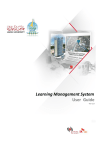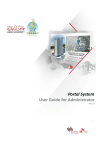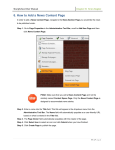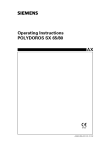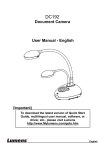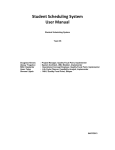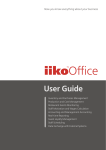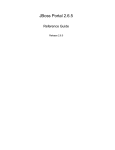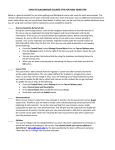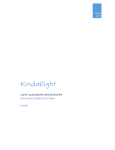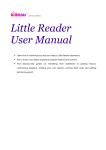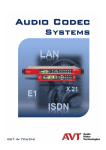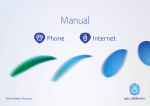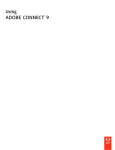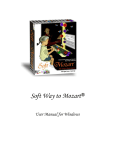Download LMS_Manual(Students)
Transcript
Learning Management System User Guide Ver 1.0 Contents 1 Overview 2 Course 3 Community 4 Counseling 5 Chatting 6 Grade 7 LMS Main 8 Main Page Setup 9 Color Theme Setup 10 Course 11 Dash Board 12 Weekly Plan 13 Virtual Lecture 14 15 16 Attending the Virtual Lecture Media Lecture Learning Contents Viewer 17 Campus Lecture 18 Bulletin 19 Basic Bulletin 20 Media Bulletin 21 Discussion 2 22 Individual Discussion 23 Group Discussion 24 25 Individual Assignment 26 Group Assignment 27 28 Team Project Using Team Project 29 Resource 30 Survey 31 Participating in Surveys 32 Survey Result 33 Quiz 34 Taking Quiz 35 Quiz Result 36 Notice 37 Q&A 38 3 Assignment Using Q&A 39 FAQ 40 Course Evaluation 41 Course Evaluation 42 Course Evaluation Result 43 Grade 44 Activity Tracking 45 Community 46 Notice 47 FAQ 48 Q&A 49 50 Creating Q&A Message 51 Incoming 52 Outgoing 53 Counseling 54 Chatting 55 Creating Chatting 56 Chat Room 57 Grade 4 Overview 1 The LMS's user friendly UI offers easy access and user convenience to optimize student learning progress. The Learning Management System's personalized UI offers user based intuitive interface design. The LMS also minimized information accessing process for user convenience, therefore achieving optimized learning progress. Figure 1-1. LMS Main Page LMS is composed of 5 menus. 1.1 Course 5 The Course menu displays all the courses the student is in enrolled in. The student can access to course information and lectures from this menu. The course menu offers course progress status, and also navigates the student to attend the desired lectures. Figure 1-2. Course 1.2 Community The Community menu is composed of 4 sub menus to manage administrator, instructor and student communities. Students can view notices posted by the LMS administrator, as well as FAQs and Q&As posted in between the administrator and LMS users. The message tool is also available for communication purposes. Notice FAQ Q&A Message 1.3 Counseling Students can manage the counseling schedule, confirm counseling requests, and view counseling request status and counseling result. 6 Figure 1-3. Counseling 1.4 Chatting Chatting menu provides chatting programs for LMS users to communicate in real time with each other. The Chatting menu provides users to instantly talk to many people at the same time by creating a chat room, or participating in existing a chat room. Figure 1-4. Chatting 1.5 Grade The students can view their enrolled courses' grades in the Grade menu. Figure 1-5. Grade 7 LMS Main 2 Personalized Learning Environment Students can construct personalized main page by configuring course portlets to manage their entire courses’ status and the courses’ schedules as well as other academic schedules. Figure 2-1. LMS Main Page The main page can be separated into GNB and Contents Area. GNB, Global Navigation Bar, is configured to proceed to other services such as Portal, SIS, and LCMS. The Contents Area provides services for students to design their own personalized portlets. LMS also provides Menu Bar, where users can add additional menus. In Contents Area, students can design the main page to display their course status, academic schedules, or any other contents according to their needs, allowing convenient access of tools and contents. 8 Content Area Figure 2-2. Main Page Composition The main page provides following functions. Table 2-1. Main Page Functions Button 9 Title Description Home Click to move to LMS Home Page. English/العربية Click to convert language (English/Arabic). Portal Click to move to portal. Manual Click to move to LCMS. Setting Click to move to SIS Log-In/Log-Out Click to download user manual. The manual will vary according to the user type. Portlet Setting Click to change LMS color theme and/or move to portlet setting page. 2.1 Main Page Setup Users can construct personalized & customized main page with functions available in the 'Setting' located in the GNB. 1.This screen will appear when a user logs in to the LMS for the first time. Click the Setting button located in the GNB to move to the Setting page. 1 2. In the Setting page, click the Portlet tab to view and configure portlet settings. 2 3 3. Select the portlet to add from the ‘Add Portlet’ panel. Once you click the portlet, the portlet box will be displayed on the screen. There are 4 types of portlets available. 1) Notice 2) Q&A 3) Learning Status 4) To Do List 4. To edit the portlet, click the ‘Edit’ button located on top right of the portlet box. Please note that you can only set portlets for your own courses. 4 5. Click apply to save the selected settings, and saved portlets can be used in main page. 5 6. To display portlet, either click the ‘+’ icon on the main page or put a mouse over the bottom part of the main page to expose the Portlet List. Click the + button of the portlet box to present the corresponding portlet to the main page. 6 6 10 7. The selected portlet can be moved around by selecting and dragging the portlet to the desired location. The portlet can be deleted from the main page by clicking the ‘x’ button located on top right of the portlet. Please note that the portlet is deleted only from the main page. If wish to delete it from the LMS, go to the Portlet Setting menu to delete. 7 2.2 Color Theme Setup Users can set the color theme of the LMS in the Setting page. 1 1. Click the Setting icon located in the GNB area. 2. On the Setting page, click the Color tab to view color settings. 2 3. Select the desired color, and the GNB color will change accordingly. The colors available are listed below: 3 1) 2) 3) 4) 4 11 Dark Cyan White Blue Beige 4. The color theme in LMS can be changed regardless of number of times changed, and page location. Course 3 Offers interactive learning environment with various learning tools LMS provides personalized learning & teaching environment equipped with various learning tools so the instructors scan create interactive educational curriculums for students. Figure 3-1. Learning Tools Available in LMS Students can view the lecture progress of the courses they're enrolled in. The course menu also offers learning tools so instructors and students, and students themselves can interact with one another. Figure 3-2. Students Interactions in Discussion Board 12 3.1 Dashboard When you click the course name, Dashboard tab will be displayed. In the dashboard, you can check the course's lecture plans by the day, week, and the month. The To-Do List is also available in the Dashboard for students to easily find out upcoming learning tools to complete. Figure 3-3. Dashboard The dashboard provides following information. Table 3-1. Dashboard Functions Title Description Displays learning tools added to the current week. Click the title of the learning tool to view detailed information. Displays learning tools that has been completed. Click the title of the learning tool to view detailed information. Displays learning tools currently in progress. Click the title of the learning tool to view detailed information. Displays upcoming learning tools. Click the title of the learning tool to view detailed information. Displays the learning tools added to the course by the month/week/day. 13 When accessing a learning tool in the Course menu, a new tab will be created to view each learning tool's contents. The tabs created will be located on the Tabs bar, allowing the users to access to the desired learning tools conveniently. Table 3-2. Functions Available in the Course Menu Button Title Description Tab Controller When learning tools are selected, the tabs will be displayed, and you can navigate the tabs with the controller. Weekly Plan Click to move to Weekly Plan page of the corresponding course. Displays all the learning tools as icons provided by the LMS. The Learning Tools panel is located in the right side of the screen, and cannot be closed. Click the learning tool icon to view the complete list of the learning tool created for each course. Tools Learning tools provided by the LMS are: 1) Syllabus 2) Virtual Lecture 3) Media Lecture 4) Bulletin 5) Team Project 6) Assignment 7) Team Project 8) Resource 9) Survey 10) Quiz Community Notice, Q&A, and FAQ of current course. Click the icon to move to the corresponding page. Learning Tool Click to move to the learning tool’s page. Semesters Lecture Plans Displays semester lecture plans by the month, week, or day. Click the icons to change. Grade Displays students’ own grades. Click to move to the Grade page. Activity Tracking Displays the students’ own learning activities. Click to move to the Activity Tracking page. 3.2 Weekly Plan Students can view the enrolled course's general information, evaluation method, and weekly learning contents, from the Weekly Plan tab. 14 Figure 3-4. Weekly Plan The weekly plan provides following information. Table 3-3. Weekly Plan Functions Title Description Course Information Displays general course information. Evaluation plan Displays the instructor’s evaluation plan of the course. Grades Displays grades. Weekly Schedule Displays the weekly schedule of the course. 3.3 Virtual Lecture Students can participate in online lecture lead by the instructor with the Virtual Lecture learning tool. 15 Depending on the instructor’s preference, the lecture can be audited by students out side of the class. The lecture can also be replayed. Figure 3-5. Virtual Lecture Information. Virtual Lecture’s settings and contents are explained below: Table 3-4. Virtual Lecture Basic Information Title Description Title Title of the Virtual Lecture. This button is activated on the scheduled virtual lecture so that users can enter the virtual lecture room by clicking the title of the virtual lecture. Date/Time Displays the period of start/end date and time for a virtual lecture. Score Setting Displays possible points students can obtain by attending the lecture. Entrance Accessibility Time Displays the time students are permitted to enter to attend the lecture. Admitted Learning Time Displays time admitted by attending the lecture. The admitted learning time is set by the instructor. Description Displays the detailed descriptions on a lecture entered by the instructor. Attachment Displays attachments available, which have been registered by a user. Click to download the desired attachments. Session Displays audit availability. ※ Students who wish to audit cannot attend the lecture if the Session is not set by the instructor. 16 Table 3-5. Virtual Lecture Additional Information Title Description Displays Replay availability in terms of the recorded and saved real-time virtual lecture. Replay The virtual lecture is classified to 3 status types according to date and time defined by the instructor Table 3-6. Virtual Lecture Classification Title Description The lecture has not started yet, therefore, is not available. The lecture has started and is in progress. To enter the lecture, click the title or the status button. The lecture has ended, and is no longer able to enter. 3.3.1 Attending the Virtual Lecture While the virtual lecture is open, users can click the title of the lecture or entrance button to enter in to the virtual lecture room. Figure 3-6. Virtual Lecture Room While in the virtual lecture room, students can chat with other students and instructors in real time, and capture the current screen to save. 17 Real-time Chatting Function Current Screen Capture The virtual lecture room is composed of 4 tabs: Document, Whiteboard, Video, and Share. The detailed descriptions are as below. Table 3-7. Virtual Lecture Room Tabs Title Description Document Students can download documents added to this tab by the instructor while attending the lecture. Whiteboard Students can capture the screen provided by the instructor, by using the annotation tool. Video The video tab is displayed when you first enter into the virtual lecture room, and students can video conference with instructor. Share tab is used when the instructor wants to share his screen with students. The share tab provide 5 types of sharing functions shown below. Share 1) Desktop Sharing 2) Application Sharing 3) Area Sharing 4) Web Sharing 5) Video Sharing Students can configure screen display, video and audio settings from the Video tab. The settings are explained below. 1 2 3 1. Displays user list currently attending the virtual lecture, and displays the instructor and students' individual settings. 2. Displays camera list available in the PC. 3. Displays the video quality settings. 4. Displays the audio quality settings. 4 5. Displays the microphone quality settings. 5 18 3.4 Media Lecture Students can attend online learning sessions regardless of time and space. The students’ attendances and learning progress will be effected automatically. Figure 3-7. Media Lecture Information Media lecture’s settings and contents are explained below. Table 3-8. Media Lecture Basic Information Title 19 Description Content Name (ID) The lecture materials are imported from the LCMS. This field displays the LCMS content title and ID of the lecture material. Title Displays title of the lecture. The users can click the title to view the lecture materials regardless of the actual lecture date. Date/Time Displays the scheduled date and time of the lecture. Students can only obtain their points within this time frame. Score Setting Displays possible points students can obtain by attending the lecture. Description Displays lecture descriptions entered by the instructor. Attachment Displays attachments available which are registered by user. Click to download the attachments. Table 3-9. Media Lecture 의 Additional Setting Title Description Admitted Learning Time Displays time admitted by attending the lecture. The admitted learning time is set by the instructor. Progress Rate Displays the student’s learning progress rate. The Media Lecture is classified to 3 status types according to date and time set by an instructor. Table 3-10. Media Lecture Classification Title Description The lecture has not started yet, therefore, is not available for students to participate. The lecture has opened and is in progress. Click the title or the status button to enter the lecture, and student attendance will be applied. The scheduled lecture period has ended. Users can still enter the lecture by clicking the lecture title, but student attendance will not be applied. 3.4.1 Learning Contents Viewer To enter the media lecture, click the lecture title or the ‘Enter’ status button. Once entered, the Learning Contents Viewer will be displayed to proceed the online learning. Figure 3-8. Learning Contents Viewer 20 The learning contents views contains following functions. Table 3-11. Learning Contents Viewer Functions Button Title Description Learning Progress Click to view learning progress window, containing course information, the total duration of the learning content, the last studied date, and the learning progress. TOC/Bookmark Displays Table of Contents for the learning content and Bookmark page. TOC displays list of contents in order of the current learning content. Bookmark only displays the list of contents selected as favorites by an user. Please note that two functions cannot be selected at the same time. Theme Settings Can set/change the theme color. There are 4 colors available. The colors are same as the LMS colors. Choose to show and hide the table of contents with ‘-’ and ‘+’ buttons. Show/Hide Table of Contents Click ‘-’ button to hide the table of contents and expand the contents viewing screen. Click ‘+’ button to show the table of contents and reduce the contents viewing screen. Table of Contents Controller Click the arrows to navigate the table of contents. If for any reason the Learning Contents Viewer shuts down, the students learning progress will be saved to the point where the viewer was closed. When the viewer is opened again, the learning material will begin from the point it was ended. 21 3.5 Campus Lecture The students can view the offline lecture information, and their attendance on the lecture in this menu. Figure 3-9. Campus Lecture Information The Campus Lecture settings and contents are explained below Table 3-12. Campus Lecture Basic Information Title Description Title Displays title of the lecture. Date/Time Displays the scheduled date and time of the lecture. Score Setting Displays possible points students can obtain by attending the lecture. Description Displays lecture descriptions entered by the instructor. Attendance Displays the students’ attendances of the lecture. Table 3-13. Bulletin Classification Title Description The lecture has not started yet, therefore, is not available for students to participate. The lecture has opened and is in progress. The scheduled lecture period has ended. The students can view their attendance. 22 3.6 Bulletin Students can utilize bulletin function included in Forums. Bulletin offers basic and media type bulletin. Figure 3-10. Bulletin Information Bulletin’s settings and contents are explained below. Table 3-14. Bulletin Basic Information Title Description Title Displays the title of the post on the bulletin. Description Displays the detailed information of the bulletin post entered by the instructor. Points Possible Displays possible points students can obtain by completing the bulletin. Period Displays the scheduled date and time students can participate in. Attachment Displays attachments available. Click to download the attachments. Grade Displays if grade is given or not. Attachment Type Displays attachment types students can upload, set by the instructor. Only displayed attachment types are available to be uploaded. Bulletin is classified to 3 status types according to date and time set by an user. 23 Table 3-15. Bulletin Classification Title Description The bulletin is not open yet, therefore, is not available. The bulletin is open and is in progress. Depending on the settings made, students are permitted to upload: 1) Posts 2) Comments 3) Attachments The bulletin is closed, and is no longer available since the scheduled date/time has been over. Users can check the bulletin posts written by the students, but not able to write a new bulletin post. 3.6.1 Basic Bulletin The basic bulletin is used for students to conduct simple tasks. Students can post bulletins when the status is open. Figure 3-11. Basic Bulletin When the bulletin status is open, instructor and students can access and post threads, and reply to any registered posts on the bulletin contents. Users can also download and view the attachments and the past bulletin contents run in previous semesters depending on the instructors setting. 24 1. While the bulletin is open, users can post bulletin contents by clicking the '+' button. ※ The instructor can restrict students from posting threads and/or replying. ※ Private bulletin can only be viewed by the writer and the instructor. 1 2. Users can also view and reply to others' posts. 2 3. And download attachments within the scheduled date/time of the corresponding bulletin. 3 2 3.6.2 Media Bulletin When media bulletin is used, the media window is displayed on the bottom so students can post contents with images. Figure 3-12. Media Bulletin 25 While the bulletin is open, users can post contents including images and view other's contents. They can also reply and view others comments as well. The images posted on the bulletin can also be downloaded, and if the past contents are imported, then past contents can also be viewed. 1. While the bulletin is open, the “+” button is activated and posting is available. ※ Posting is possible in accordance with configurations that an instructor established. ※ If the “Private” is checked, posted contents are only opened to the writer and the instructor. 1 2. Posted contents can be viewed in a pop-up layer and put a reply on them. 2 3. The attached files of a post can be downloaded. 3 26 3.7 Discussion The discussion tool, located under the Forums, is used for students to discuss opinions and ideas. The discussion types are group and individual discussion sessions. Figure 3-13. Discussion Information Discussion settings and contents are explained below: Table 3-16. Discussion Information Title Description Title Displays the title of the post on the discussion Description Displays the detailed information of the discussion entered by the instructor. Score Setting Displays possible points students can obtain by completing the discussion. Date/Time Displays the scheduled date and time students can participate in. Grade Displays if grade is given or not. Attachment Type Displays attachment types students can upload, set by the instructor. Only displayed attachment types are available to be uploaded. The Discussion is classified to 3 status types according to date and time. Table 3-17. Discussion Classification Title Description The discussion is not open yet, therefore, is not available. 27 Table 3-17. Discussion Classification Title Description The discussion is open and is in progress. Depending on the settings made, students can: 1) Post comments 2) Post attachments 3) Be in groups The discussion is closed, and nothing can be posted. 3.7.1 Individual Discussion If the group settings are not used, then individual discussion will be created. Once the discussion is open, students can add discussion posts by clicking the ‘+’ button in the discussion page. Figure 3-14. Individual Discussion Once the discussion is open, instructor and students can post and view other discussions and also reply/comment and view others’ discussion posts. Users can also download attachments, like and/or recommend posts. By using the like/recommend functions, users can select which posts to read, and also distinguish users preferences in real time. If the instructor chose to import the past data, then students can also view the past discussion contents of previous semesters. 28 1. Once entered in the discussion, students can add discussions by clicking the '+' or ‘ button to post discussions. 1 ※ Depending on the instructor's setting students may or may not be able to reply toward others’ posts. ※ Group Discussion’s posting authority will be classified as Group Leader Only or Individual. 2 2. While the discussion is open, users can view each other's posts and reply to them. 3 4 3. Users can also download available attachments. 4. Like and/or recommend others’ posts. 2 3.7.2 Group Discussion If the group settings are used to create discussion, then group discussion session will be created. Once the discussion is open, discussion session per group will be created like shown below Figure 3-15. Group Discussion Once the discussion is open, group members can post and view other discussions and also reply/comment and view others’ discussion posts. Users can also download attachments, like and/or recommend posts. By using the like/recommend functions, users can select which posts to read, and also distinguish users preferences in real time. If the instructor chose to import the past data, then students can also view the past discussion contents of previous semesters. 29 3.8 Assignment The Assignment tool, located under the Forums, can be used for students to submit assignments. The assignments are classified as group and individual assignment. Figure 3-16. Assignment Settings and Contents Assignment settings and contents are explained below: Table 3-18. Assignment Basic Information Title Description Title Displays the title of the assignment. Description Displays assignment information written by the instructor. Points Possible Displays possible points students can obtain by completing the assignment. Period Displays the scheduled date and time students can complete the assignment. Attachment Displays attachments available. Click to download the attachments. Grade Given Displays if grade is given or not. Displays the submission method the students must hand in the assignment. There are 4 submission types available: Submission Method 1) Attachment 2) Hard Copy 3) Attachment + Hard Copy 4) Board Number of Submissions Allowed Displays how many times a student can submit for an assignment. An instructor can set the maximum number of assignment submission. Attachment Type Displays attachment types students can upload, set by the instructor. Only displayed attachment types can be uploaded. 30 The Assignment is classified to 3 status types according to the scheduled date and time set by an instructor. Table 3-19. Assignment Classification Title Description The assignment is not open yet, therefore, is not available. The assignment is open and is in progress. Depending on the settings made, students can: 1) Post comments 2) Post attachments 3) Be in groups The assignment is closed, and nothing can be posted. 3.8.1 Individual Assignment If the group settings are not used, then individual assignment will be created. Once the assignment is open, the students can add assignment. Figure 3-17. Individual Assignment Once the assignment is open, the students can access and submit the assignment according to the instructor’s settings (submission method, number of submission allowed). 31 1. Once entered in the assignment page,, students can submit assignments by clicking the '+' or ‘ button to post discussions. 1 ※ The number of assignment submission will be limited by the instructor’s setting. 2 2. The students can edit/delete/re-submit the assignment, while the assignment status is open. 3. Once the assignment status is closed and the instructor has viewed the assignments, students can view the instructor’s feedback on their assignment by clicking their submissions. 3 3.8.2 Group Assignment If the group settings are used to create assignment, then group assignment will be crated. Once the assignment status is open, the group session will be created for students to submit assignments. 32 Figure 3-18. Group Assignment Once the assignment is open, the students can access and submit the assignment according to the instructor’s settings (submission method, number of submission allowed). 1. Once entered in the assignment page,, students can submit assignments by clicking the '+' or ‘ button to post discussions. 1 ※ The number of assignment submission will be limited by the instructor’s setting. ※ Group assignment’s submission authority will be classified as Group Leader Only or Individual. 2 2. The students can edit/delete/re-submit the assignment, while the assignment status is open. 3. Once the assignment status is closed and the instructor has viewed the assignments, students can view the instructor’s feedback on their assignment by clicking their submissions. 3 33 3.9 Team Project Students can work on projects with the Team Project tool located under Forums. Figure 3-19. Team Project Settings and Contents Team project’s settings and contents are explained below. Table 3-20. Details of Team Project Title Description Title Displays the title of the team project. Description Displays the team project information entered by the instructor. Points Possible Displays possible points students can obtain by submitting the team project. Period Displays the scheduled date and time set by an instructor to allow students to access and submit the team project. Attachment Displays attachments available. Click to download the attachments. Grade Displays if grade is given or not. Attachment Type Displays attachment types students can upload, set by the instructor. Only displayed attachment types can be uploaded. The Team Project is classified to 3 status types according to the scheduled date and time set by an instructor. 34 Table 3-21. Team Project Classification Title Description The team project is not open yet, therefore, is not available. The team project is open and is in progress. The team project is closed, and nothing can be posted. 3.9.1 Using Team Project Once the team project is open, students can view the project information and post their project. Figure 3-20. Team Project Page Once the team project opens, students can enter into their group to view and submit their project. Students can also view their group members’ submission and post comment. 35 1. Once entered in the group’s team project page, students can submit project by clicking the '+' or ‘ button to post discussions. 1 2. Students can also view group members’ submissions. 3. And download available attachments. 2 3 36 3.10 Resource The students can download resource, provided by the instructor, from the resource tool. Figure 3-21. Resource Settings and Contents Resource’s settings and contents are explained below. Table 3-22. Resource Basic Information Title 37 Description Title Displays the title of the resource. Description Displays the resource information entered by the instructor. Link URL Displays URL link of the resource added by the instructor. Click to proceed to the corresponding URL page. Attachment Displays media lecture attachments added by the instructor. Click to download the attachment(s) 3.11 Survey Students can complete surveys and course evaluations, created by the instructor, in this menu. Students must complete the course evaluation to view the enrolled courses’ final grade. Figure 3-22. Survey Settings and Contents Survey’s settings and contents are explained below. Table 3-23. Survey Basic Information Title Description Title Displays the title of the survey. Date/Time Displays the duration of the survey set by an instructor. Description Displays survey information entered by the instructor. The Survey is classified to 3 status types according to the scheduled date and time set by an instructor. Table 3-24. Survey Classification Title Description The survey has not started yet, therefore, is not available. The survey has started, and is in progress. The survey result will automatically applied as students complete the survey in real time. 38 Table 3-24. Survey Classification Title Description The survey has ended, and users can no longer participate in the survey. 3.11.1 Participating in Surveys Once the survey status turns to Open, the ‘Participate’ button will be activated for students to participate in the survey. 1. Click the ‘Participate’ button to enter in to the survey. 1 2. Complete the survey, and click the ‘Save’ button to finish. 2 3.11.2 Survey Result Users can only participate in the survey once (cannot participate in the same survey). Once the survey is complete, the ‘Participate’ button will be de-activated. Click the ‘View Result’ button to view the survey result. Users can view the survey result of all participants in real time. Figure 3-23. Survey 39 3.12 Quiz Students can take online quiz in the LMS (offline, midterm, and final quiz are not supported by the online quiz). Figure 3-25. Online Quiz Settings and Contents Quiz settings and contents are explained below. Table 3-25. Online Quiz Basic Information Title Description Displays the quiz type the instructor has selected. The quiz types provided in Quiz tool are explained below. Type 1) Online Quiz ( Only regular quiz can be created.) 2) Offline Quiz (Quiz, Midterm, and Final quiz is available.) Title Displays the title of the quiz. While the quiz status is open, students can click the quiz title to participate in the quiz. Date/Time Displays the scheduled date and time of the quiz set by an instructor. Time Permitted (Mins.) Displays the length of time that students are permitted to take the quiz. The time is shown in minutes. (Only available in online quiz.) Score Setting Displays possible points students can obtain by attending the lecture. Number Of Trials Allowed Displays how many time students are allowed to take the quiz (Only available in online quiz). Description Displays quiz information entered by the instructor. Score / Available Score Feedback Displays the quiz score. Once the quiz is completed, the ‘View’ button will appear for students to view their quiz results. Displays the instructor’s feedback on the quiz. 40 The Quiz is classified to 3 status types according to date and time. Table 3-26. Online Quiz Classification Title Description The quiz has not started yet, therefore, is not available. The quiz is open and is in progress. If the quiz can be taken more than once, the students can retake the quiz while the quiz status is open. The quiz is closed. Students can view their quiz result. 3.12.1 Taking Quiz Once the quiz is open, the quiz title will be activated for students to enter the quiz. 1. Click the quiz title to participate in the quiz. The pop-up window will open when the title is clicked. 1 2 3 41 2. Complete the quiz within the time permitted by the instructor. The remaining time will be displayed on top right of the window. Click the ‘Submit button once the quiz is complete. 3. Once the quiz is submitted, the quiz title will become deactivated. If quiz re-take is allowed, click the ‘Re-submit’ button to re-take the quiz. 3.12.2 Quiz Result Once the quiz is completed, students can view the quiz result and instructors feedback in the LMS. Figure 3-26. Quiz Result 1. Once the quiz is complete, click the ‘View’ button to view the quiz result. 1 2. Check the quiz result. 2 42 3.13 Notice The students can view the news and important notices regarding the course in this menu. The notice board is composed of Top notice and general notice. Figure 3-27. Notice Board Notice settings and contents are explained below. Table 3-27. Notice Board Information Title Description Title Displays the title of the notice. Description Displays notice information entered by the instructor. Attachment Displays attachments available. Click to download the attachments. Newly added notices will have 'N‘ sign appearing next to the title. Click the title to view the full notice. Figure 3-28. Newly Added Notice, Notice Type: Top 43 3.14 Q&A Questions and answers regarding the course will be posted in the Q&A board. Q&A board provides a space for students to ask questions regarding the course, and for instructors to answer. Figure 3-27. Q&A Board Q&A components are explained below. Table 3-26. Q&A Components Title Description Question Students post questions regarding the course. Answer Answers are posted by the instructor . 3.13.1 Using Q&A The students can click the ‘+’ button located in the Q&A page to post questions. 1 44 1. Click the ‘+’ to proceed to the next step, 2 2. Post questions regarding the course. Posted questions can be viewed in the Q&A board. Figure 3-28. . Q&A Board: Answer Field Click the question title to view the question details. Student can edit their own post by clicking the ‘Edit’ button. The post can also be deleted by clicking the ‘Delete’ button. When the post is deleted, the instructor’s answer will be deleted as well. 45 3.15 FAQ Frequently asked questions and the answers regarding to the course are managed in the FAQ board. Only the instructor can post in the FAQ board. Figure 3-29. FAQ Board The FAQ components are explained below. Table 3-27. FAQ Components Title Description Question Frequently asked questions about the course by the students. Answer The instructor’s answers to the questions. Newly added FAQ will have 'N‘ sign appearing next to the title. Click the title to view the full details. Figure 3-30. Newly Added FAQ Screen 46 3.16 Course Evaluation After completing the course, students can evaluate the course. Please note that the students must complete the course evaluations in order to view their final grades. Figure 3-33. Course Evaluation Settings and Contents Course Evaluation’s contents and settings are explained below. Table 3-30. Course Evaluation Basic Information Title Description Title Displays the course evaluation title. Period Displays the duration of the course evaluation set by the instructor. Description Displays the course evaluation information entered by the instructor. The Course Evaluation is classified to 3 status types according to the scheduled date and time set by an instructor Table 3-31. Course Evaluation Classification Title Description The course evaluation has not started yet, therefore, is not available. The course evaluation has started, and is in progress. The course evaluation result will automatically applied as students complete the course evaluation in real time. 47 3.16.1 Course Evaluation Once the course evaluation is open, the ‘Participate’ button to evaluate the course. 1. Click the ‘Participate’ button to evaluate the course. 1 2 Once the course evaluation is completed, click the ‘Save’ button to complete the evaluation. 2 3.16.2 Course Evaluation Result Once participated, the students can’t re-participate in the course evaluation, even if the status is open. The ‘Participate’ button will be deactivated once evaluation is done. Click the ‘View Result’ button to view the course evaluation result. Users can view the result of all participants in real time. Figure 3-34. Course Evaluation Result 48 3.17 Grade Once the students complete the course evaluation, the Grad menu will be activated. Students can view the grades track their course activities. Figure 3-31. Grades Grade component is explained below. Table 3-28. Grade Component Title Description Click the learning tool percentage to view the activity progress. Pop-up window will open. Learning Tool Click the learning tool’s percentage to open the pop-up window to view the activities done by the student. 1. Select the learning tool. 1 2. Student’s participation and activity history will be displayed in the pop-up window. 2 49 3.18 Activity Tracking Students can utilized the Activity Tracking menu to view their learning activities and progress. Figure 3-31. Activity Tracking Activity Tracking component is explained below. Table 3-29. activity Tracking Component Title Description Click the learning tool percentage to view the activity progress. Pop-up window will open. Learning Tool Students can view their learning tool activities and progress by clicking the learning tool percentage in the activity tracking menu. The activity tracking result will be displayed in the pop-up window. 1. Select the learning tool. 1 2. Student’s participation and activity history will be displayed in the pop-up window. 2 50 4 Community Share academic knowledge with staffs and students in the Community. Community menu offers 5 services -Notice, FAQ, Q&A, Message, and Manual functions- for students and staffs to conveniently share academic knowledge and various information. Figure 4-1. Community Functions The administrator posts notices for users in the notice board. FAQ is also used by the administrator to post LMS's frequently asked questions and answers. The Q&A is also available for users to post questions regarding to LMS. The LMS users can also use the LMS messaging system to communicate with each other among staff, instructors and students. Notice FAQ Q&A Message 51 4.1 Notice The notice board is used by the administrator to post notices for the LMS users. The Top notice and regular notice are used. Figure 4-2. Notice Board Notice contents and settings are explained below. Table 4-1. Notice Contents Title Description Title Displays the title of the notice. Top Notice The Top notices will always stay on top of the list. Description Displays the notice information entered by the administrator. Attachment Displays attachment(s) added by the administrator. Click to download the attachments. Newly added notices will have 'N‘ sign appearing next to the title. Click the title to view the full notice. Figure 4-3. Newly Added Notice, Notice Type: Top 52 4.2 FAQ Frequently asked questions to the administrator and the administrator’s answers are available in the Community’s FAQ board. Figure 4-4. FAQ Board FAQ has following components: Table 4-2. FAQ Components Title Description Question Questions frequently asked by the users to the administrator. Answer Administrator’s answers to the questions. Newly added FAQ will have 'N‘ sign appearing next to the title. Click the title to view the full details. Figure 4-5. New FAQ 53 4.3 Q&A All LMS users, including students can post questions, regarding to the LMS, to the administrator. Once the administrator responses to the questions, answers will be available to be viewed. Users can also view other questions and answers posted on the Q&A board. Figure 4-6. Q&A Board Q&A has following components: Table 4-3. Q&A Components Title Description Question Users post questions regarding LMS to the administrator. Answer Answers are posted by the administrator. 5.3.1 Creating Q&A To create Q&A, click the ‘+’ button on the Q&A board and post questions. 1 1. Click ‘+’ button to proceed to next page. 54 2 2. Enter the question(s). The Q&A will be uploaded to the Q&A board. Figure 4-7. . Q&A Board: Answer Field Click the title of the Q&A to view full detail. You can edit or delete your own Q&A with 'Edit' and 'Delete' button. Only the administrator can edit the answers but users can only delete both question and answers of their own Q&A. 55 4.4 Message The message function offers users to send messages to other LMS users, and they can view their message histories. Figure 4-8. Message Page The message page is composed of Received and Sent tabs. LMS users can access to all the Received messages and reply to the sender from the Received tab. The Sent tab saves all the Sent messages and can view if the message has been read or not by the receiver. Message can be sent from the Sent tab. 4.4.1 Received Received Tab’s settings and contents are explained below: Table 4-4. Received settings and contents Title Description Title Title of the Received message. Click the title to see the full message. Message will be displayed underneath the title. Description Displays full message. Delete Check the messages to delete and click the 'Delete' button. The deleted message cannot be recovered. Reply Click to reply to the message. 56 Figure 4-9. Received Messages Click the title of message to view the full message. You can delete the unnecessary messages, and/or reply to the corresponding sender. 1. Click the ‘Reply’ button to reply to the sender. Pop-up window will open. 1 2. Enter the title and message, then click ‘Send’. When replying, contents below should be filled. 2 1) Title 2) Contents 4.4.2 Sent Sent Tab settings and contents are explained below. Table 4-5. Sent Settings and Contents Title Title 57 Description Title of the Sent message. Click to message title to view the sent message's full contents. Table 4-5. Sent Settings and Contents Title Description Description Displays the Sent message contents. Delete Check the messages to delete and click the 'Delete' button. The deleted message cannot be recovered. Figure 4-10. Sent Messages When the message is first sent, the message status will be displayed as 'Unread'. After the message is received and read by the receiver, the status will change to 'Read'. To send message, click the 'New' button. 1. To send message, click the ‘New’ button. Pop-up window will be displayed. 1 2. Click the '+' button to add receiver. 2 3. Enter the message and click the 'Send' button to send the message. 3 58 5 Counseling User convenience and systematic management. By using the calendar provided by the LMS, the students can request counseling sessions, view the counseling request status, and counseling result. Figure 5-1. Counseling Calendar Counseling configurations are explained below. Table 5-1. Counseling Configurations Title Description ‘+’ Click to move to the counseling request page. Pending Pending counseling requests. Counseling requests of the counseling session are displayed. Approved The counseling session is approved. Approved counseling session details are displayed. Complete The counseling session is completed. Counseling result will be displayed. Cancel Displays cancelled counseling session. 59 Figure 5-2. Counseling Details Counseling request instructions are explained below. 1. Click the ‘+’ button to move to the counseling request page. 1 2 2. Click the ‘Search’ button to search for the instructor to request counseling. 2 3 60 3. After selecting the instructor, click the ‘Request Counseling’ to view the instructor’s available counseling sessions. 4 4. Click the desired date and time to request counseling, enter the required information needed to request counseling, and click the ‘Ok’ button to send the request to the instructor. After the counseling request, Click the status bar to view the counseling status. Depending on the instructor’s response the status will be changed to either ‘Approved’ or ‘Rejected’. Counseling Status - Pending Counseling Status - Approved Counseling Status - Complete Counseling Status - Cancel If the counseling request was rejected, rejection reason will also be sent to the students. The student can re-apply to request the counseling session on different date and/or time depending on the rejection reason. 61 Once the instructor creates counseling sessions, then the students can view the available dates and hours and can request counseling on the given time. The instructor then, can view the requested counseling sessions and either accept or reject the students’ counselling requests. 1. Move the mouse cursor over the desired Pending date to view student(s) requested for counseling. 1 2. Click the Pending date to approve student for counseling. 2 ※ Only 1 student can be accepted, and the rest student(s) requested will automatically be rejected, . Once the counseling session is approved, the instructor will hold counseling session with the student on the scheduled date and time. After the counseling is finished, the counseling result will be uploaded. 1 1. Once the counseling session is over, the instructor can upload counseling result by clicking the corresponding session in the calendar. 2. The below will contents will be contained in the counseling result. 2 1) Counseling Performance Status. 2) Counseling Result. Once the counseling session is performed, the status will display 'O', and the status will display 'X' when not performed. When the progress is complete, 'Complete' will be displayed. Once the counseling session is complete, the counseling result will be available in pop-up window when the user moves the mouse cursor over. 62 6 Chatting Live communication between the users with the Chatting tool. The chatting tool is active as long as the user is logged in to the LMS. To chat, create a chat room, or enter the existing chat room. The Chatting tool offers users to chat 1:1 and/or with multiple users. Figure 6-1. Chatting Window and Chat Rooms Chatting settings and contents are explained below. Table 6-1. Chatting Settings and Contents Title Description All Click ‘Jazan’ tab to view all chat rooms available. Users can enter into the available chat room. Course Click the 'Course' tab to select the course and view chat rooms to enter. Can also create chat room. The permitted users are limited to the course currently enrolled. Department Users enrolled in the same department can chat with each other. Create a chat room, or enter the existing chat room to chat. 63 6.1 Creating Chatting The chat rooms can be created from 1:1 chat room to course chat room and campus chat room. The chatting history generated in the chat room is available to be viewed until the user leave the chat room. Once exited, all contents will be unavailable. 1Depending on the users included in the chat room, select either Course or Department. 1 2. Click the 'Create Chat Room' button to proceed to next step. 2 3 3. Enter the chat room title and select users to invite into the chat room. 4. Click the 'Create' button to create a chat room. 6.2 Chat Room Once the chat room is created, the chat room users will be displayed. The users in the chat room can chat with each other by entering chats in the text box provided on the bottom of the page. 64 Figure 6-2. Chat Rooms On the top right of the chat room is an icon for setting options. Depending on the position, such as the chatting room leader and participants, the options will vary. Table 6-2. Chat Room Options Title Description Invite Click to invite participant. This function is available to everyone in the chat room. Participants Click to view the participants and their profile. This function is available to everyone in the chat room. Dismiss Click to dismiss participant(s) from the chat room. This function is only available to the chat room leader. Once dismissed, the participant can't reenter the chat room. Leave Click to leave the chat room. Once exited, all chats will be deleted and won't be able to recover. This function is available to everyone in the chat room. 65 Grade 7 View final grades of enrolled courses Students can view the grades of currently enrolled courses in the Grade menu. Figure 7-1. Grade Students can view their grades by searching the enrolled courses by year and semester. The grade will not be displayed, if the course evaluation is not complete. Click the instructor’s name to view the instructor profile, and students can send messages via SMS and email from the profile window. 66


































































